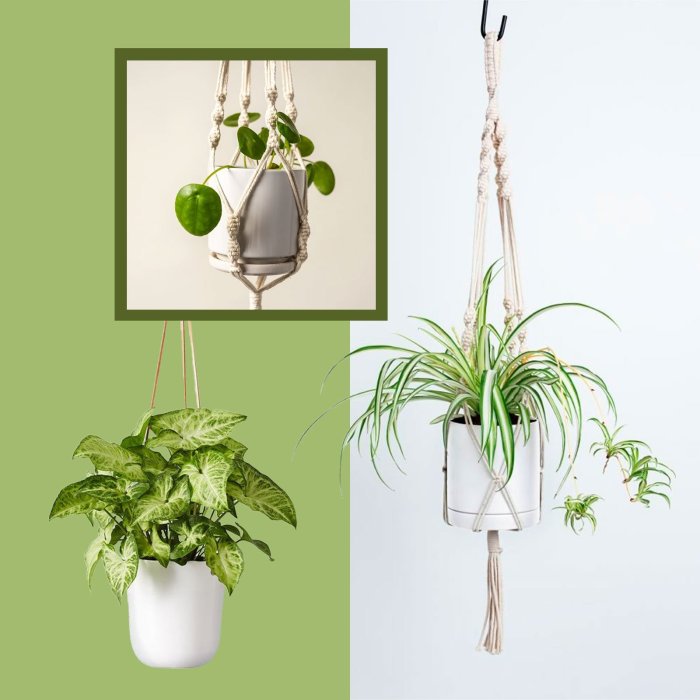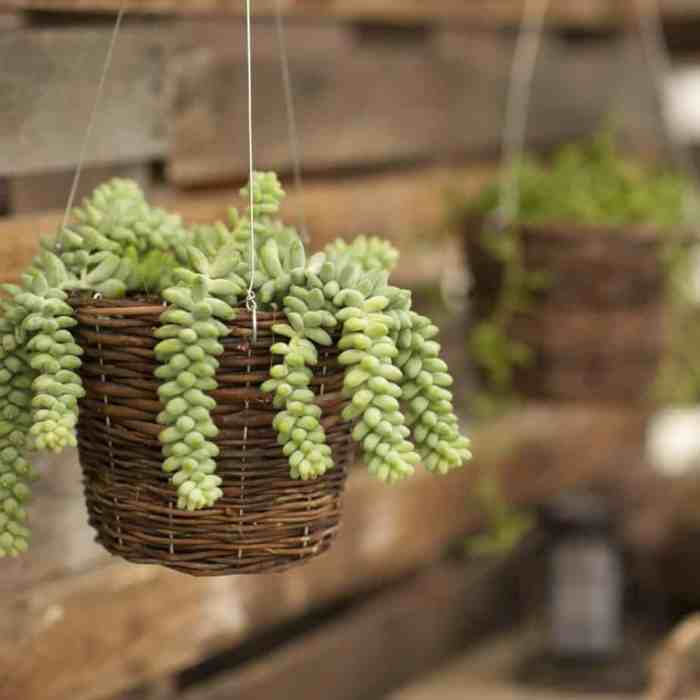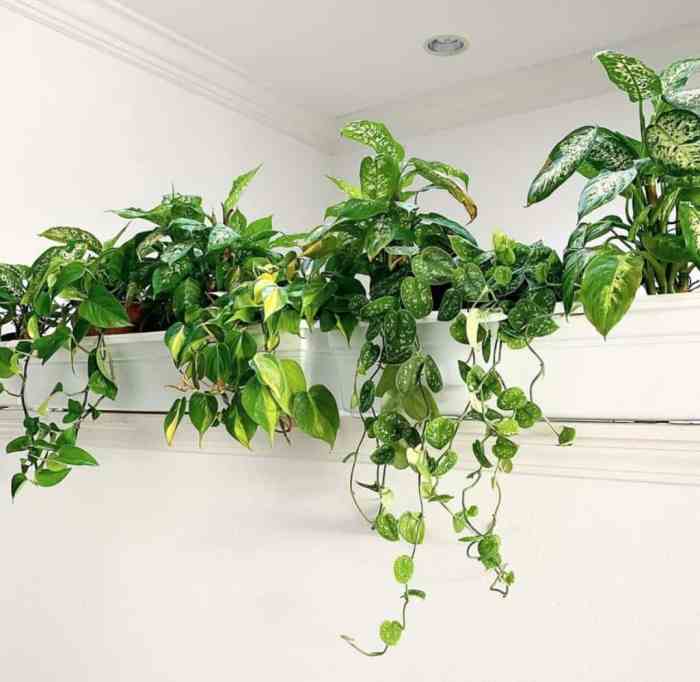Embrace the transformative power of live hanging plants indoor, where nature meets artistry to elevate your living spaces. From purifying the air to enhancing well-being, these verdant companions bring a touch of tranquility and vitality to any room.
Explore the diverse range of hanging plants, each with unique characteristics and care requirements. Discover innovative ways to display them, creating captivating focal points and maximizing space. Whether you’re a seasoned plant enthusiast or a novice gardener, this guide empowers you to create a thriving indoor oasis.
Benefits of Indoor Hanging Plants
Incorporating live hanging plants into indoor spaces offers a multitude of benefits, ranging from air purification to enhanced mental well-being.
Air Purifying Qualities
Live hanging plants act as natural air purifiers, effectively removing harmful toxins and pollutants from the indoor environment. Studies have shown that certain plant species, such as spider plants, peace lilies, and snake plants, are particularly effective at absorbing and breaking down volatile organic compounds (VOCs) released from building materials, cleaning products, and other household items.
Impact on Mental Well-being and Stress Reduction
Research has demonstrated that the presence of hanging plants indoors can have a positive impact on mental well-being and stress reduction. The vibrant greenery and natural elements provided by plants can create a calming and soothing atmosphere, reducing stress levels and promoting relaxation.
Additionally, studies have shown that interacting with plants can lower blood pressure, improve mood, and enhance cognitive function.
Types of Indoor Hanging Plants
Indoor hanging plants add a touch of greenery and freshness to any space. They come in various types, each with unique characteristics and care requirements. To help you choose the perfect hanging plant for your home, we have compiled a comprehensive list of popular options.
Light Requirements
When selecting a hanging plant, consider the amount of natural light your space receives. Some plants thrive in bright indirect light, while others can tolerate low light conditions.
| Botanical Name | Common Name | Light Requirements |
|---|---|---|
| Epipremnum aureum | Golden Pothos | Low to bright indirect light |
| Chlorophytum comosum | Spider Plant | Bright indirect light |
| Tradescantia zebrina | Wandering Jew | Bright indirect light to low light |
Growth Habits
Hanging plants can have different growth habits, from trailing vines to bushy shrubs. Choose a plant that complements the size and shape of your hanging basket or pot.
- Trailing Vines:These plants grow long, cascading stems that gracefully drape over the edges of containers. Examples include Pothos, Spider Plants, and Wandering Jew.
- Bushy Shrubs:These plants have a more compact, upright growth habit. Examples include Peperomia, Ficus pumila, and Chinese Evergreen.
Size
The size of a hanging plant should be proportionate to the space available. Consider the height and width of the plant when selecting a hanging basket or pot.
| Botanical Name | Common Name | Size |
|---|---|---|
| Hoya carnosa | Wax Plant | Small to medium |
| Monstera deliciosa | Swiss Cheese Plant | Medium to large |
| Nephrolepis exaltata | Boston Fern | Large |
Hanging Plant Care
Maintaining the health and beauty of indoor hanging plants requires proper care, including watering, fertilizing, and pruning. Additionally, being aware of common pests and diseases can help prevent and address any issues that may arise.
Watering
The frequency of watering for hanging plants depends on factors such as the type of plant, the size of the pot, and the environment. As a general rule, water the plants when the top inch or two of soil feels dry to the touch.
Avoid overwatering, as this can lead to root rot. Allow excess water to drain from the pot before hanging it back up.
Fertilizing
Fertilize hanging plants every few weeks during the growing season, using a balanced liquid fertilizer diluted to half strength. Avoid over-fertilizing, as this can damage the roots. In the winter, reduce fertilizing to once a month or less.
Pruning
Regular pruning helps maintain the shape and size of hanging plants. Remove dead or damaged leaves and stems, and trim back overgrown branches to encourage new growth. Pruning also helps improve air circulation and light penetration.
Live hanging plants indoor can bring a touch of nature into your home, purifying the air and adding a splash of color. For those who want to add some greenery to their space, hanging house plants are a great option.
These plants can be easily suspended from the ceiling or hung on walls, making them perfect for small spaces or apartments. Live hanging plants indoor can create a calming and inviting atmosphere, making them a great addition to any room.
Common Pests and Diseases
Hanging plants can be susceptible to pests such as aphids, mealybugs, and spider mites. Treat infestations promptly using insecticidal soap or neem oil. Common diseases include powdery mildew, root rot, and botrytis. Treat diseases with fungicides or by improving ventilation and reducing humidity.
Live hanging plants indoor can brighten up any space, adding a touch of nature and freshness. From cascading ferns to trailing succulents, there are many good hanging plants to choose from. These plants can help purify the air, improve humidity, and create a calming atmosphere.
Whether you’re looking for a statement piece or a subtle addition to your decor, live hanging plants indoor are a great way to bring life to your home.
Creative Hanging Plant Displays: Live Hanging Plants Indoor

Hanging plants offer a unique way to add greenery and life to indoor spaces. Beyond the traditional hanging baskets, there are countless creative ways to showcase these plants and create stunning visual displays.
One innovative approach is to use macrame hangers. These intricately knotted cords provide a bohemian and stylish way to suspend plants from the ceiling or walls. Macrame hangers come in various sizes and designs, allowing for customization and personalization.
Ceiling Hooks
Ceiling hooks are another versatile option for hanging plants. These hooks can be screwed into the ceiling and used to suspend plants directly from above. This creates a cascading effect that can be particularly striking when used with trailing plants like pothos or ivy.
Wall-Mounted Shelves
Wall-mounted shelves provide a practical and decorative way to display hanging plants. These shelves can be installed at different heights and depths, creating a layered effect that adds visual interest to a room. Plants can be hung from the shelves using hooks or cords, and the shelves themselves can be used to display other decorative items like books or artwork.
Grouping and Arrangement
Grouping and arranging hanging plants strategically can create a cohesive and visually appealing display. By combining plants of different sizes, shapes, and colors, it is possible to create a dynamic and eye-catching arrangement. Trailing plants can be used to create a cascading effect, while upright plants can add height and structure.
Privacy Screens and Architectural Features, Live hanging plants indoor
Hanging plants can also be used to create privacy screens or accentuate architectural features. By suspending plants in front of windows or doorways, they can help to create a sense of privacy while still allowing natural light to enter the room.
Hanging plants can also be used to highlight architectural details such as beams or columns, adding a touch of greenery and warmth to the space.
DIY Hanging Plant Projects

Harnessing creativity and upcycling household items, DIY hanging plant projects offer unique and cost-effective ways to enhance indoor greenery.
Macrame Plant Hangers
Craft elegant macrame plant hangers using basic knotting techniques:
- Gather macrame cords, scissors, and a plant pot.
- Cut four cords twice the desired hanger length.
- Create a lark’s head knot to attach the cords to a ring or dowel.
- Divide the cords into two groups and tie square knots until the desired length is reached.
- Join the two groups and create a double half hitch knot.
- Trim excess cords and attach the pot to the hanger.
Repurposed Household Items
Transform everyday objects into charming hanging planters:
- Suspend a woven basket from the ceiling using a rope or chain.
- Drill holes in a glass jar and attach leather straps or twine for a rustic touch.
- Paint an old teacup or saucer and hang it with wire or string.
DIY Plant Stands and Trellises
Create custom plant displays with DIY stands and trellises:
- Assemble a hanging shelf from wooden planks and rope for multiple plants.
- Build a metal or wooden trellis to support climbing plants vertically.
- Use recycled materials like pallets or PVC pipes to create unique hanging planters.
Epilogue

Immerse yourself in the world of live hanging plants indoor, where the fusion of nature and creativity transforms your home into a sanctuary. Experience the purifying benefits, embrace the calming effects, and revel in the aesthetic beauty they bring. With the knowledge and inspiration provided in this guide, cultivate a thriving indoor ecosystem that nourishes your mind, body, and soul.
Question Bank
How often should I water my hanging plants?
Water when the soil feels slightly dry to the touch, usually once or twice a week.
What are some common pests that affect hanging plants?
Aphids, mealybugs, and spider mites are common pests. Treat with insecticidal soap or neem oil.
Can I hang plants in low-light areas?
Yes, there are many low-light tolerant plants, such as pothos, snake plants, and ZZ plants.